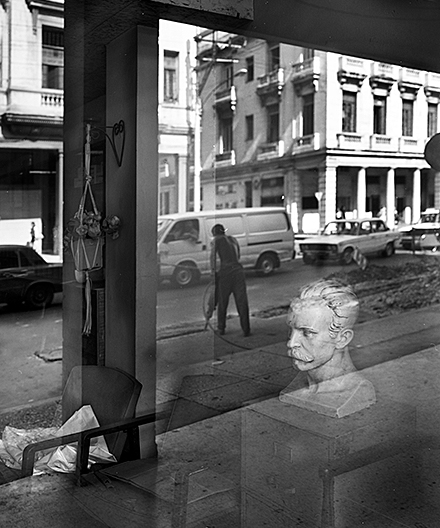Cultural Visions Part Four: Cuba Rising
I am seeing so many beautiful portfolios from Cuba these days, especially on www.socialdocumentary.net and their magazine, ZEKE. All these pictures got me inspired to scan some more negatives from my time in Cuba 15 years ago. All photos ©Frank Ward, except the last one ©Susan S. Bank. Previously, I published pictures about Cuba here.
View of Havana from El Morro, 2002.

A hitchhiker along the Malecon.

Gas station, Havana.

Solitude and Havana fit together like the pages of a great novel.




The above b/w photos are from Trinidad de Cuba, a few hours drive from Havana.

A welder taking a break from his work. Below, the bust of Cuban poet Jose Marti.

My Cuba work was done over a three week period in 2002. Susan S. Bank has been photographing Cuba for decades. I recently wrote a review of her book, Piercing the Darkness, picturing her output from 1999 to 2010.

Bank’s Cover photo for Piercing the Darkness.
My review for ZEKE Magazine:
A photo book is such a precious object in this age of picture-saturated cyberspace. At its best, the photo book stands as an artist’s statement in dialog with history. In the case of Susan S. Bank’s Piercing the Darkness, not only is the book a beautifully designed and sequenced telling of the first ten years of the 21st century in Cuba, it is a highly personalized view created with 20th century intent, style and processes. Bank’s Leica, her black and white film and her choice of lenses create a world apart from her contemporaries’ colorful Cuba travelogues. I have never seen Havana with so few old cars. Bank also skirts the seductive pleasure of the elegant, decayed architecture. The Malecón, Havana’s boulevard along the bay, is in only a few compositions. Her camera prefers to look down at the pavement and into the buildings. Fortunately, Bank does acknowledge the thousands of dogs to whom Cuba has granted the freedom to roam.
Piercing the Darkness begins in shadow. We see slumped workers with backs turned in chiaroscuro. Faces are hidden or masked. Bank masterfully photographs arms and hands, letting them direct the viewer’s eye across the frame. Many pictures are about Cubans in contact, sizzling with gesticulation and assertion. Bank is present when they argue or embrace, and often, these vignettes reveal the scars of Cuba’s crimes committed in the name of ideology.
I found myself viewing each page like a detective at a crime scene. The details unfold slowly, and the most telling evidence lies in the shadows. She certainly named her collection wisely. Like Robert Frank’s Americans, Bank’s Cubans are people with a shared mythology best expressed through their sense of solitude. We are viewing the work of an artist who knows her subject well and refuses to make simple pictures about complex lives. Bank is not telling the story of Cuba; she is telling the story of humanity through pictures of Cuba.
Frank, so beautifully written, let alone photographed. Where have you been keeping these amazing images? Would love to see more larger. To my taste the hitchiker and the gas station speak to long walks by you? The sparse architecture framing that Caribbean air works so well in black and white.
Thanks, Peter. I hope you are enjoying Havana as you read this.
Frank, thank you for an astute reading of my works in my Havana monograph, Piercing the Darkness. While many of us wind up on the Malecon, I edited pictures I have never seen before. To tackle Havana is indeed risky business. Sincerely, Susan S. Bank